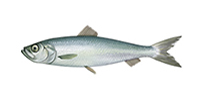Thank you for visiting the Seafood Selector. EDF is planning a new approach to providing information to consumers about good seafood choices. Please come back soon for updates.
Herring

Herring
Recommended servings per month
| Contaminant | Men | Women | Kids 6-12 | Kids 0-5 | |
|---|---|---|---|---|---|
| Alewife | Mercury | 4+ | 4+ | 4+ | 4+ |
| Atlantic herring | Mercury | 4+ | 4+ | 4+ | 4+ |
| Pacific herring | Mercury | 4+ | 4+ | 4+ | 4+ |
Eco details:
- These small fish swim in large schools and are related to shads, sardines and menhadens.
- Strong joint management between the U.S. and Canada helped revive the Atlantic herring fishery, and populations of these herring appear to be on the rise.
- Alewife, or river herring, were abundant in the late 1950s, but habitat loss and overfishing drastically reduced stocks.
- Pacific herring are highly prized for their roe (eggs) in Asia. Populations appear to be a fraction of what they used to be.




